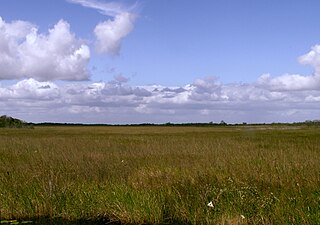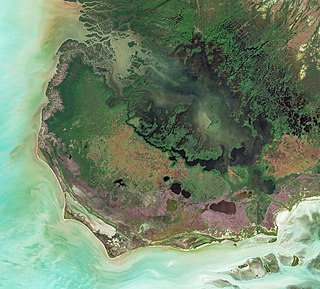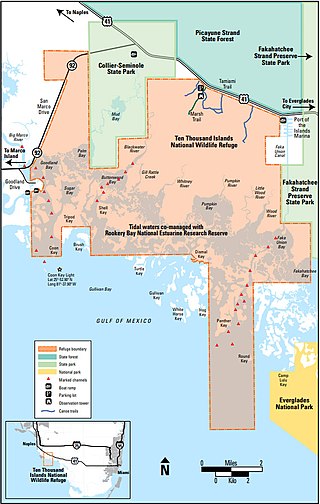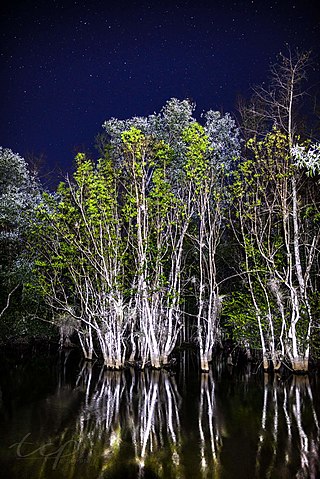
The Everglades is a natural region of flooded grasslands in the southern portion of the U.S. state of Florida, comprising the southern half of a large drainage basin within the Neotropical realm. The system begins near Orlando with the Kissimmee River, which discharges into the vast but shallow Lake Okeechobee. Water leaving the lake in the wet season forms a slow-moving river 60 miles (97 km) wide and over 100 miles (160 km) long, flowing southward across a limestone shelf to Florida Bay at the southern end of the state. The Everglades experiences a wide range of weather patterns, from frequent flooding in the wet season to drought in the dry season. Throughout the 20th century, the Everglades suffered significant loss of habitat and environmental degradation.

Chokoloskee is an unincorporated community and census-designated place (CDP) located at the edge of the Ten Thousand Islands in Collier County, Florida, United States. The population was 345 at the 2020 census, down from 359 at the 2010 census. It is part of the Naples–Marco Island Metropolitan Statistical Area.

Everglades City is a city in Collier County, Florida, United States, of which it was once the county seat. It is part of the Naples–Marco Island Metropolitan Statistical Area, which is included in the Cape Coral-Fort Myers-Naples Combined Statistical Area. The Gulf Coast Visitor Center for Everglades National Park is located in Everglades City. As of the 2020 US census, the population was 352, down from 400 in the 2010 US census.

Everglades National Park is an American national park that protects the southern twenty percent of the original Everglades in Florida. The park is the largest tropical wilderness in the United States and the largest wilderness of any kind east of the Mississippi River. An average of one million people visit the park each year. Everglades is the third-largest national park in the contiguous United States after Death Valley and Yellowstone. UNESCO declared the Everglades & Dry Tortugas Biosphere Reserve in 1976 and listed the park as a World Heritage Site in 1979, and the Ramsar Convention included the park on its list of Wetlands of International Importance in 1987. Everglades is one of only three locations in the world to appear on all three lists.

Key Biscayne is an island located in Miami-Dade County, Florida, located between the Atlantic Ocean and Biscayne Bay. It is the southernmost of the barrier islands along the Atlantic coast of Florida, and lies south of Miami Beach and southeast of Miami. The key is connected to Miami via the Rickenbacker Causeway, originally built in 1947.
The Tamiami Trail is the southernmost 284 miles (457 km) of U.S. Highway 41 (US 41) from State Road 60 (SR 60) in Tampa to US 1 in Miami. A portion of the road also has the hidden designation of State Road 90 (SR 90).

Big Cypress National Preserve is a United States National Preserve located in South Florida, about 45 miles west of Miami on the Atlantic coastal plain. The 720,000-acre (2,900 km2) Big Cypress, along with Big Thicket National Preserve in Texas, became the first national preserves in the United States National Park System when they were established on October 11, 1974. In 2008, Florida film producer Elam Stoltzfus featured the preserve in a PBS documentary.

Cape Sable is the southernmost point of the United States mainland and mainland Florida. It is located in southwestern Florida, in Monroe County, and is part of the Everglades National Park.

The Ten Thousand Islands are a chain of islands and mangrove islets off the coast of southwest Florida, between Cape Romano and the mouth of the Lostmans River. Some of the islands are high spots on a submergent coastline. Others were produced by mangroves growing on oyster bars. Despite the name, the islets in the chain only number in the hundreds.

The Shark River Slough Archeological District is a historic district within the Everglades National Park in Miami-Dade County, Florida, United States, west of Homestead, that is listed on the National Register of Historic Places.

The Anhinga Trail is a short trail in the Everglades National Park. Located 4 miles from the park entrance, it starts at the Royal Palm Visitor Center. The trail is a paved walkway and a boardwalk over Taylor Slough, a freshwater sawgrass marsh. Abundant wildlife is visible from the trail, including alligators, turtles, anhingas, herons, and egrets. It is one of the most popular trails in the park. On November 5, 1996, it was added to the U.S. National Register of Historic Places.
The indigenous people of the Everglades region arrived in the Florida peninsula of what is now the United States approximately 14,000 to 15,000 years ago, probably following large game. The Paleo-Indians found an arid landscape that supported plants and animals adapted to prairie and xeric scrub conditions. Large animals became extinct in Florida around 11,000 years ago.

Before drainage, the Everglades, a region of tropical wetlands in southern Florida, were an interwoven mesh of marshes and prairies covering 4,000 square miles (10,000 km2). The Everglades is both a vast watershed that has historically extended from Lake Okeechobee 100 miles (160 km) south to Florida Bay, and many interconnected ecosystems within a geographic boundary. It is such a unique meeting of water, land, and climate that the use of either singular or plural to refer to the Everglades is appropriate. When Marjory Stoneman Douglas wrote her definitive description of the region in 1947, she used the metaphor "River of Grass" to explain the blending of water and plant life.

A national push for expansion and progress toward the latter part of the 19th century stimulated interest in draining the Everglades, a region of tropical wetlands in southern Florida, for agricultural use. According to historians, "From the middle of the nineteenth century to the middle of the twentieth century, the United States went through a period in which wetland removal was not questioned. Indeed, it was considered the proper thing to do."

Indian Key was an unincorporated community in Monroe County and, for a while, Dade County, Florida, United States. It was located in the upper Florida Keys on the island of Indian Key and is currently a ghost town.

The South Florida Council is a 501(c)(3) organization chartered by the Boy Scouts of America to serve Broward, Miami-Dade, and Monroe Counties in South Florida. As of 2022, the South Florida Council had a membership of more than 20,000 youth and adults in traditional and in-school and after-school programs.

Shark River Slough (SRS) is a low-lying area of land that channels water through the Florida Everglades, beginning in Water Conservation Area 3, flowing through Everglades National Park, and ultimately into Florida Bay. Together with Taylor Slough to the east, Shark River Slough is an essential conduit of overland freshwater to Florida Bay. Shark River Slough is also known as the "River of Grass."
Spanish Indians was the name Americans sometimes gave to Native Americans living in southwest Florida and in southernmost Florida during the first half of the 19th century. Those people were also sometimes called "Muspas". Seminoles, Muscogees, Alabamas, and Choctaws were also reported to be living in southwest and southern Florida in the early 19th century. Many Native Americans were employed by and often resident at Spanish-Cuban fishing ranchos along the coast of southwest Florida. During the Second Seminole War, a band led by Chakaika that lived in the Shark River Slough in the Everglades was particularly called "Spanish Indians". The residents of the fishing ranchos and, after Chakaika's death in 1840, many people from his band, were sent west to the Indian Territory, and Spanish Indians were no longer mentioned in the historical record. Scholars long regarded the Spanish Indians as likely a surviving remnant of the Calusa people. More recent scholarship regards the Spanish Indians as Muskogean language-speakers who had settled in southern Florida in the 18th century and formed a close association with Spaniards, or were even beginning to form a Spanish-Native American creole people.
Fishing ranchos were fishing stations located along the coast of Southwest Florida used by Spanish Cuban fishermen in the late 18th and early 19th centuries. The Spanish fished the waters along the coast of Florida in the late fall and winter of each year, salting the fish, and then carrying the cured fish to Havana by the beginning of Lent. The Spanish fishermen hired Native Americans who lived along the coast as guides and to help with catching and curing the fish, and with sailing to Havana. The Spanish established fishing stations, called "ranchos", on islands along the coast as bases during the fishing season. The Native American workers lived year-round at the ranchos, or moved to the nearby mainland during the off-season to hunt and raise crops. Many of the Spanish fishermen eventually started living at their ranchos year-round. They married or formed relationships with Native American women, and their children grew up at the ranchos, so that many of the workers were mixed of Spanish and Native American descent. All of the residents of the ranchos spoke Spanish. One author has suggested that a Spanish-Native American creole society was forming in the ranchos by the second quarter of the 19th century. The fishermen also carried Native Americans from Florida to Havana and back on a regular basis.



















